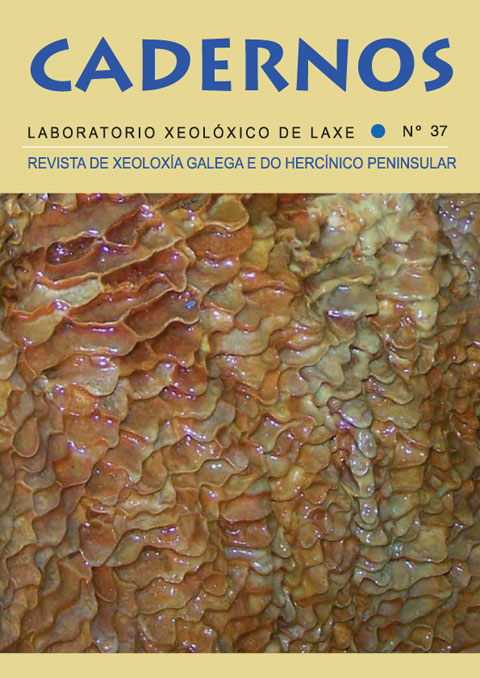The Valborraz tungsten mine: Description of a potential source of arsenic pollution
Main Article Content
Abstract
Soil contamination levels were studied in the land affected by an abandoned tungsten mine in Valdeorras (NW Spain). The mine worked mainly in the first half of the twentieth century, and it was definitely closed by 1953. Soil samples were taken in thirteen points within the mine (including both natural soils and soils developed over mine wastes), and in two natural soils close to the mine area. Total heavy metals (Fe, Zn, Ni and Cu) and As were analyzed by X-ray fluorescence in sieved (< 2 mm) ground samples. Extremely high As levels (>1000 mg kg-1) were found in all the samples of the mine area, whereas for the heavy metals analyzed no abnormally high concentrations were observed. Although high As background levels are common in soils developed over slates in the region, the concentrations found for the natural soils within the mine were too high to have a geological origin, and they are probably due to contamination from the close mine dumps. The As concentrations in the mine soils were higher than in the natural soils, ranging from 0.5-1% approximately. The highest As concentrations (near 4%) were found in iron oxyhydroxide deposits, which precipitate directly from water in some places in the area. This high As concentrations represent a certain threat to environmental health which has not been quantified yet. Although additional research is needed to determine the potential ecological and human health risks associated with the mine, our results suggest that this location could act as a dangerous As source.
Keywords:
Downloads
Article Details
References
Adriano, D. C. (2001). Trace elements in terrestrial environments. Biogeochemistry, bioavailability and risk of metals. Springer, New York.
Bodega, F. (1982). Resultados de la investigación en el Grupo “Tres Amigos”, Casayo (Orense). Cadernos do Laboratorio Xeolóxico de Laxe, 6, 441-458.
Boyle, R. W. and Jonasson, I. R. (1973). The geochemistry of arsenic and its use as an indicator element in geochemical prospecting. Journal of Geochemical Exploration, 2, 251-296.
Cárdenes, V., De La Horra, R., Monterroso, C., Garcíaguinea, J. and Pais, V. (2008). Depósitos de pizarras para cubiertas en la Península Ibérica. En: Resúmenes VII Congreso Geológico de España. Sociedad Geológica de España, Las Palmas de Gran Canaria.
Martínez Cortizas, A. and Pérez Alberti, A. (1999). Atlas climático de Galicia. Xunta de Galicia, Santiago de Compostela.
Dani, S. U. (2010). Arsenic for the fool: An exponential connection. Science of the Total Environment, 408, 1842-1846.
F.A.O. (2006). World Reference Base for Soil Resources 2006. Food and Agriculture Organization of the United Nations, Rome.
García-Guinea, J., Lombardero, M., Roberts, B. and Taboada, J. (1997). Spanish Roofing Slate Deposits. Transactions of the Institute of Mineral Metallurgy, Section B, 106, 205-214.
García-Sánchez, A., Alonso-Rojo, P. and Santos-Francés, F. (2010). Distribution and mobility of arsenic in soils of a mining area (Western Spain). Science of the Total Environment, 408, 4194-4201.
García Tato, I. (1996). Valdeorras de cara al año 2000. Instituto de Estudios Valdeorreses, Ourense.
Guitián Ojea, F. (ed.) (1992). Atlas geoquímico de Galicia. Xunta de Galicia, Santiago de Compostela.
Guitián, F. and Carballas, T. (1976). Técnicas de análisis de suelos. Ed. Pico Sacro, Santiago de Compostela.
Gurriarán, R. (2000). Da prerromanización ao wolfram: Apuntamentos históricos das explotacións mineiras en Valdeorras. Instituto de Estudios Valdeorreses, Ourense.
Hurlbut, C. S. and Klein, C. (1985). Manual of Mineralogy. 20th ed. John Wiley and Sons, New York.
I.A.R.C. (1982). Monographs on the Evaluation of the Carcinogenic Risk of Chemicals to Humans, vol. 23, Some Metals and Metallic Compounds. IARC, Lyon.
Johnson, M. S., Cooke, S. A. and Stevenson, J. K. (1994). Revegetation of metalliferous wastes and land after metal mining. En: Hester, R. E., Harrison, R. M. (Eds.), Mining and its environmental impact. Royal Society of Chemistry, Cambridge, pp. 31-48.
Julivert, M., Marcos, A. and Truyols, J. (1972). L´évolution paléogéographique du Nord-Ouest de l´Espagne pendant l´Ordovicien-Silurien. Bulletin de la Societé Géologique de Bretagne, 4, 1-7.
Jung, M. C. and Thornton, I. (1994). Heavy metal contamination in soils and plants around a copper-tungsten mine in South Korea. Environmental Geochemistry and Health, 16, 92.
Kabata-Pendias, A. and Pendias, H. (1984). Trace elements in soils and plants. CRC Press, Boca Raton.
Lide, D. R. (1996). CRC Handbook of Chemistry and Physics. 77th ed. CRC Press, Boca Raton.
Liu, C., Luo, C., Gao, Y., Li, F., Lin, L., Wu, C. and Li, X. (2010). Arsenic contamination and potential health risk implications at an abandoned tungsten mine, southern China. Environmental Pollution, 158, 820-826.
Macías, F. and Calvo, R., (2008). Niveles genéricos de referencia de metales pesados y otros elementos traza en suelos de Galicia. Consellería de Medio Ambiente e Desenvolvemento Sostible, Xunta de Galicia, Santiago de Compostela, 229 pp.
Marcos, A. (1973). Las series del Paleozoico inferior y la estructura herciniana del occidente de Asturias (NW de España). Trabajos de Geología, 6, 1-113.
Özcan, A. and Çağatay, M. N. (1988). Tungsten exploration in semiarid environment: Central Anatolian massif, Turkey. Journal of Geochemical Exploration, 31, 185-199.
Pérez-Estaún, A. (1978). Estratigrafía y estructura de la rama S de la Zona Asturoccidental-Leonesa. Memorias del Instituto Geológico y Minero de España, 92, 1-151.
Richmond, W. R., Loan, M., Morton, J. and Parkinson, G. M. (2004). Arsenic removal from aqueous solution via ferrihydrite crystallization control. Environmental Science and Technology, 38, 2368-2372.
Smedley, P. L. and Kinniburgh, D. G. (2005). Arsenic in groundwater and the environment. En: O. Selenius (Ed.), Essentials of Medical Geology: Impacts of the Natural Environment on Public Health. Elsevier, Amsterdam, pp. 263-299.
Terrón Mendaña, T. (1989). El estraperlo del wólfram en las minas de Casaio. Instituto de Estudios Valdeorreses, Ourense.
Vaughan, D. J. (2006). Arsenic. Elements, 2, 71-75.







